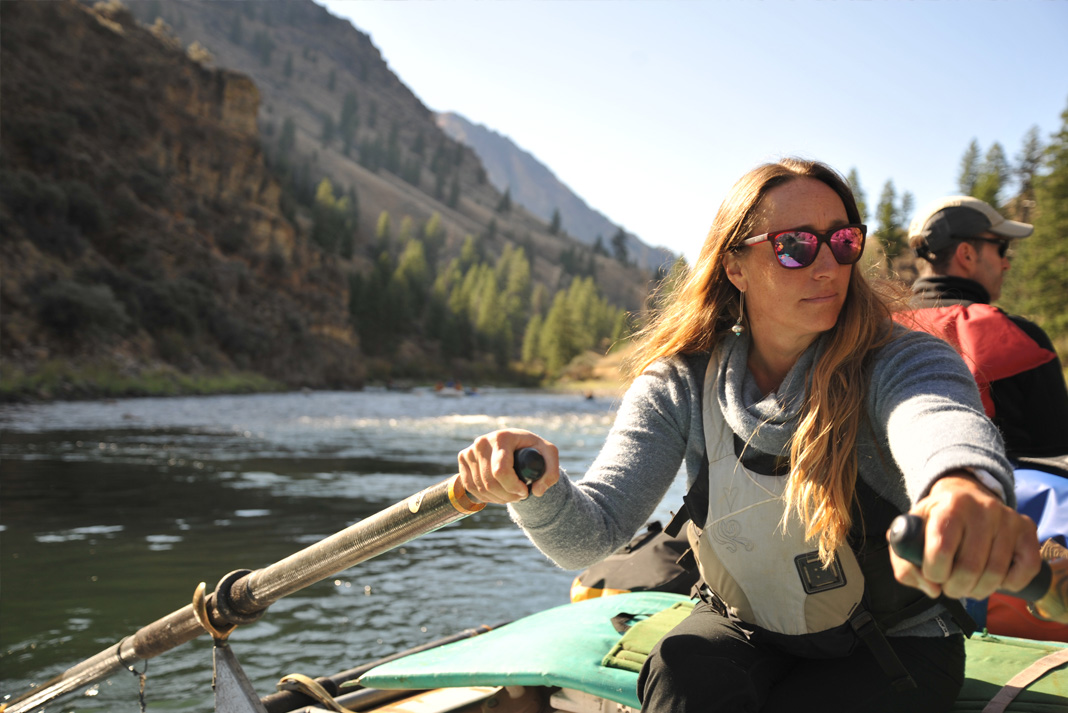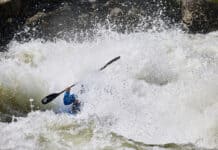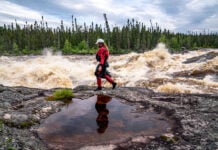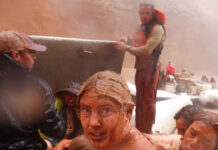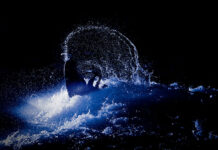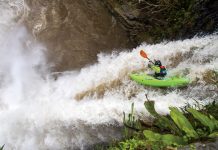Impassable Canyon. The name conjures a rocky defile so steep, no trails penetrate its shadowy depths. Just the sight of it turned Lewis and Clark on their heels. The canyon’s granite ramparts tower more than a vertical mile above the boulder-choked rapids of the Middle Fork of the Salmon—as if the sheer walls of Yosemite have been transplanted to central Idaho.
“This canyon is in the heart of the Idaho Batholith,” ARTA (American River Touring Association) lead guide, Billie Prosser, tells the spellbound passengers aboard her 18-foot oar rig. I nod and smile in what I hope is a convincing simulacrum of understanding. Fortunately, Prosser saves me, dispensing interpretive nuggets with the same quiet competence and measured pace with which she rows the technical low-water rapids of the Middle Fork in mid-September.
These north-flowing, sparklingly clear waters follow a natural fault line, she continues, carving a front-row seat to the state’s spectacular geology. Tens of millions of years ago, colliding tectonic plates shoveled prehistoric seafloor sediments deep into the earth’s crust, then thrust the rock skyward. We are looking at the cooled cores of powerful, dinosaur-era volcanoes. I’d been thinking, “If these walls could talk…” Now they are, thanks to Prosser.
Too often, when I’m exploring somewhere new, my guide is of the paperback or spiral-bound variety. Joining Prosser and her ARTA colleagues—Idaho river managers Tanner Welch and Tess Howell, and assistant guide, Abby Hudson—for this trip, I realize what I’ve been missing: the human connection. It’s a familiarity and affinity for a place—whether it be a river, range or coast—that professional guides cultivate through years of observing, studying and inhabiting these environments. It’s visceral and highly individual, and it sure as hell isn’t something you can buy on Amazon.
Several miles into the upper canyon, we pull ashore at a spacious bench shaded by Ponderosa pines and follow Prosser up a narrow footpath. She climbs past yellow-flowering sagebrush to the base of an overhanging cliff and waits while our eyes find a panel of human and animal figures, painted rusty red on the smooth stone. We learn these pictographs were made some 500 to 1,000 years ago by the Tukudeka (or Sheepeater) people, a resourceful and reclusive band of Shoshoni who once thrived in the craggiest canyons and most remote ranges of the Sawtooth Mountains.
As a bald eagle turns lazy circles in the thermals over our heads, we speculate about the drawings’ possible meaning. Then Prosser shares an illustrative experience she had while rowing with a Zuni elder on the Colorado River in Arizona. At a petroglyph site she had puzzled over on previous trips, the elder demystified the complex pattern of pecking and etching: “It is a map of the Grand Canyon.”
True, it wasn’t the map of the canyon Prosser and her fellow river guides knew like the backs of their sun-beaten hands. It didn’t reflect the same ways of relating to the land and water as those handed down by Western explorers, geographers and cartographers. The petroglyph map was cryptic, Prosser mused, only because modern river runners have inherited a different form of literacy.
Below Big Creek, the walls of Impassable Canyon close in for the final 20-mile run to the Middle Fork’s confluence with the Main Salmon. Later, we will pitch our last camp on a white sand beach and watch a full moon drape dazzling white light over the granite ridges. Right now, however, the sun is flaring warm and welcome above the canyon rim. Beyond the next bend, Veil Falls billows like a beaded curtain in the breeze.
I have yet to crack the spine on my 382-page The Middle Fork—A Guide. Instead, I’m reading the river. I’m listening to my companions’ stories. I’m watching Prosser articulate the subtle tapestry of currents with the dip of an oar, the book’s mile-by-mile map sheets long forgotten in my drybag.
Virginia Marshall is a former editor of Rapid and Adventure Kayak magazines.
River guides like ARTA’s Billie Prosser are the voice of the canyon. | Featured photo: Virginia Marshall


